1lumen selects and reviews products personally. We may earn affiliate commissions through our links, which help support our testing.
ThruNite TT20 review
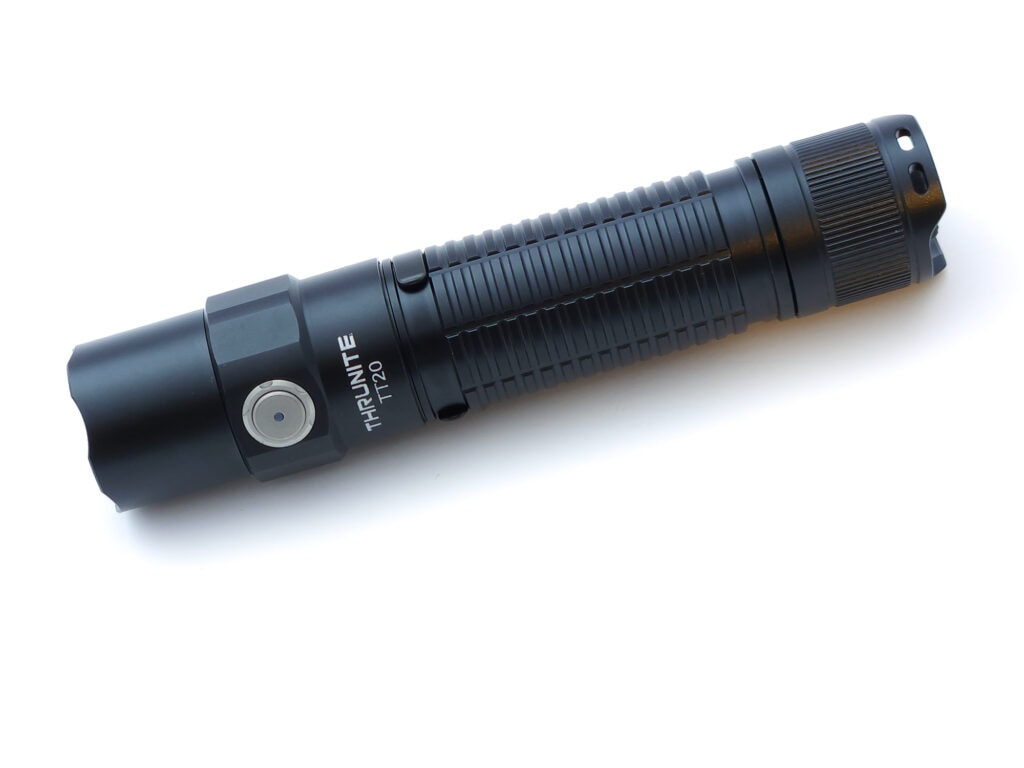
ThruNite TT20 specs
| Brand & Model | ThruNite TT20 |
|---|---|
| Flashlight category | EDC, rechargeable tactical flashlight |
| LED | Luminus SST-70 |
| Max. output | 2,526 lumens |
| Max. beam distance | 258 meters |
| Max. beam intensity | 16,650 cd |
| Battery config. | 21700*1 |
| Onboard charging | USB-C |
| Modes | Smooth Ramping |
| Blinkies | Strobe |
| Waterproof | IPX8 |
| Review publication date | April 2023 |
Review intro:
The TT20 is a 21700 tactical/ EDC flashlight which ThruNite released in 2020. Coming with the battery, onboard charging, and a host of accessories, it’s an accessible light, as you really don’t need anything else to start up. The TT20 follows the familiar pattern of many ThruNite tube lights by having dual switches, but comes with a smooth ramping interface instead of the LMH which is more common, plus it comes in a number of colors!
Package quality.
ThruNite puts the TT20 into a fairly plain, brown cardboard box and nestles it in a foam cutout. When you lift that out, you’ll find the accessories beneath. The box has some general ThruNite branding and a UPC sticker with the model of the light inside.
The complete contents of the box include:
- ThruNite TT20 with ThruNite 21700 battery inside and clip installed
- Holster
- Plastic zip-top bag with lanyard and spare o-rings inside
- USB-C charging cable
- Instruction manual
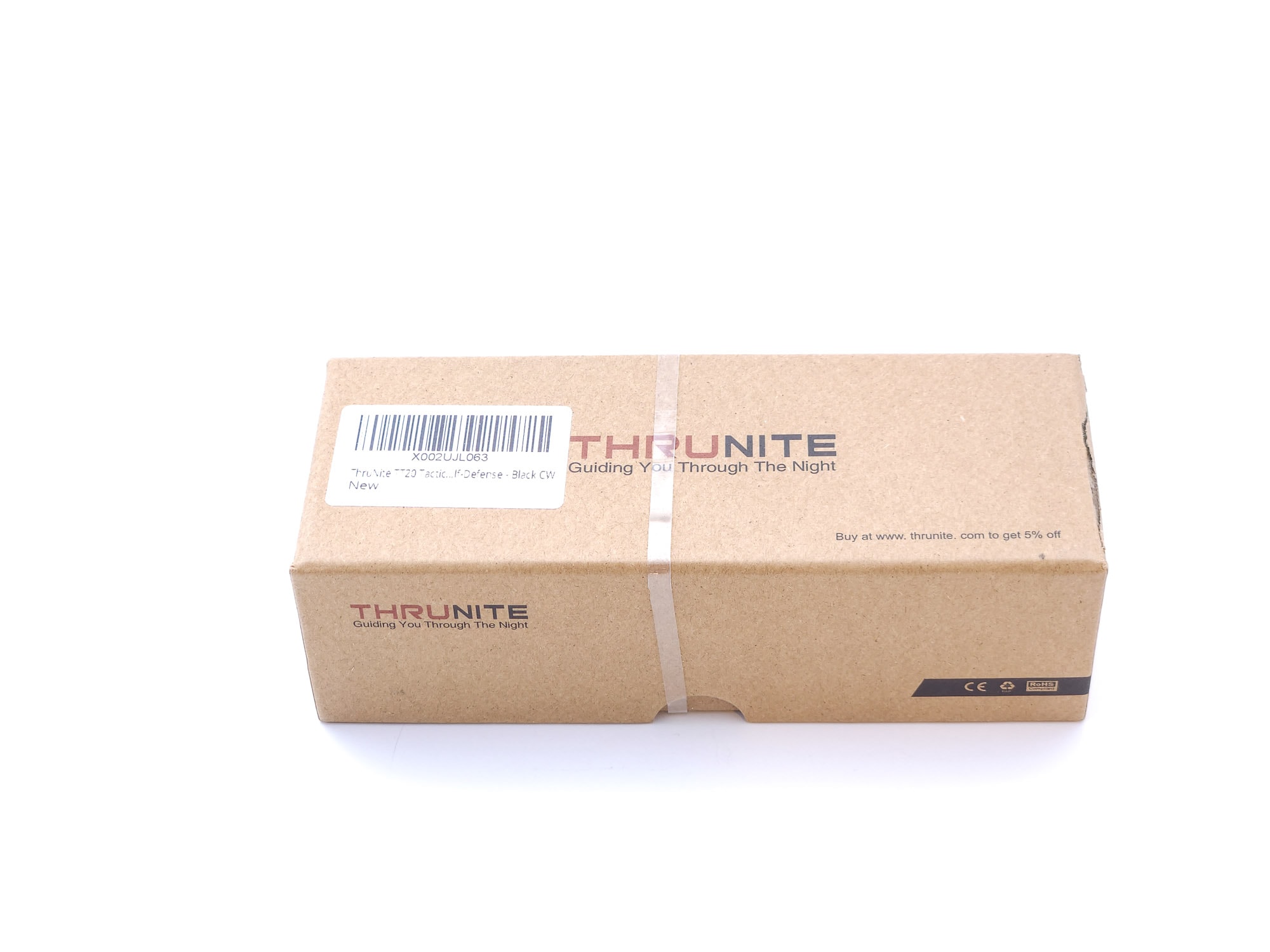
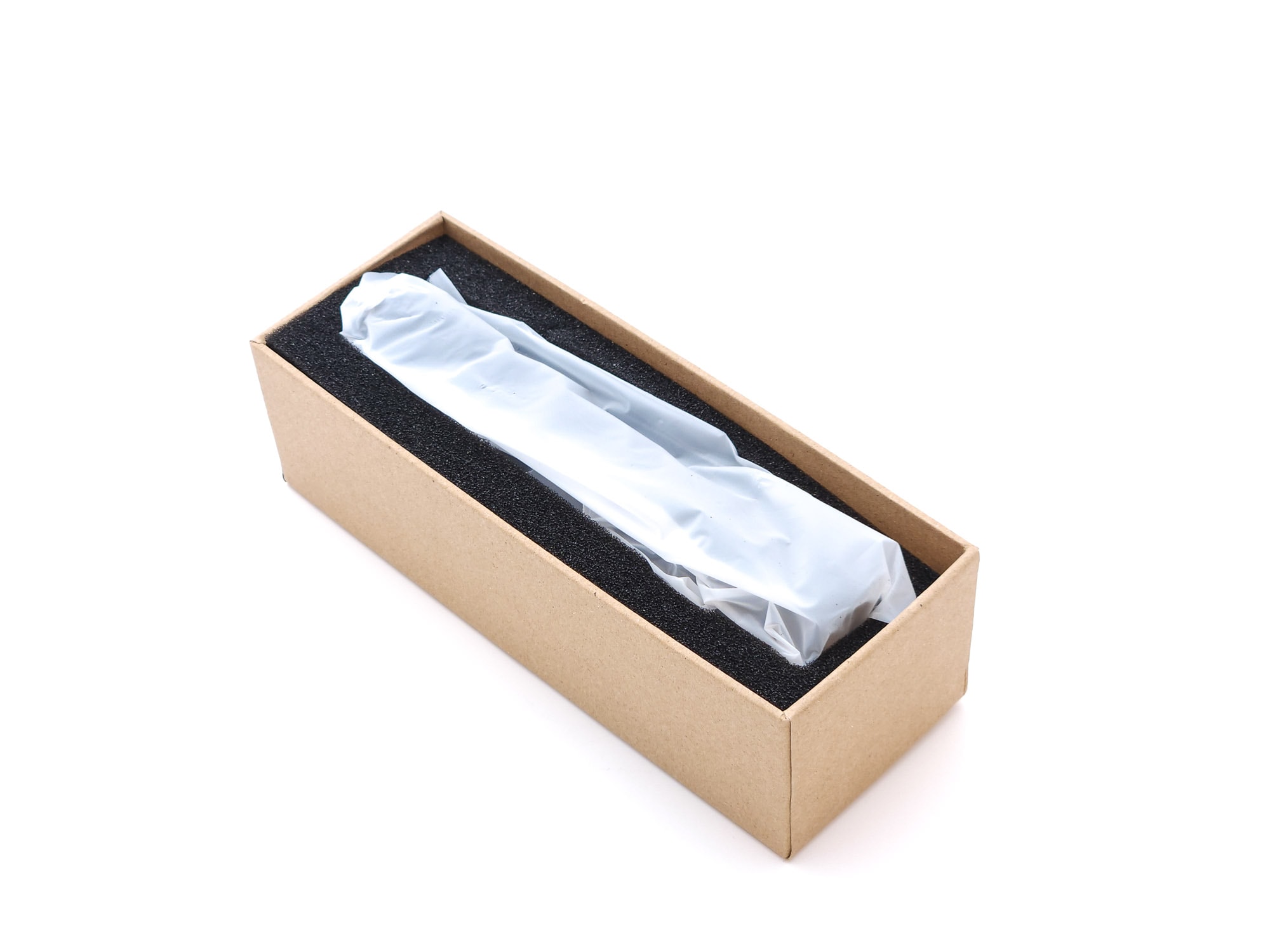
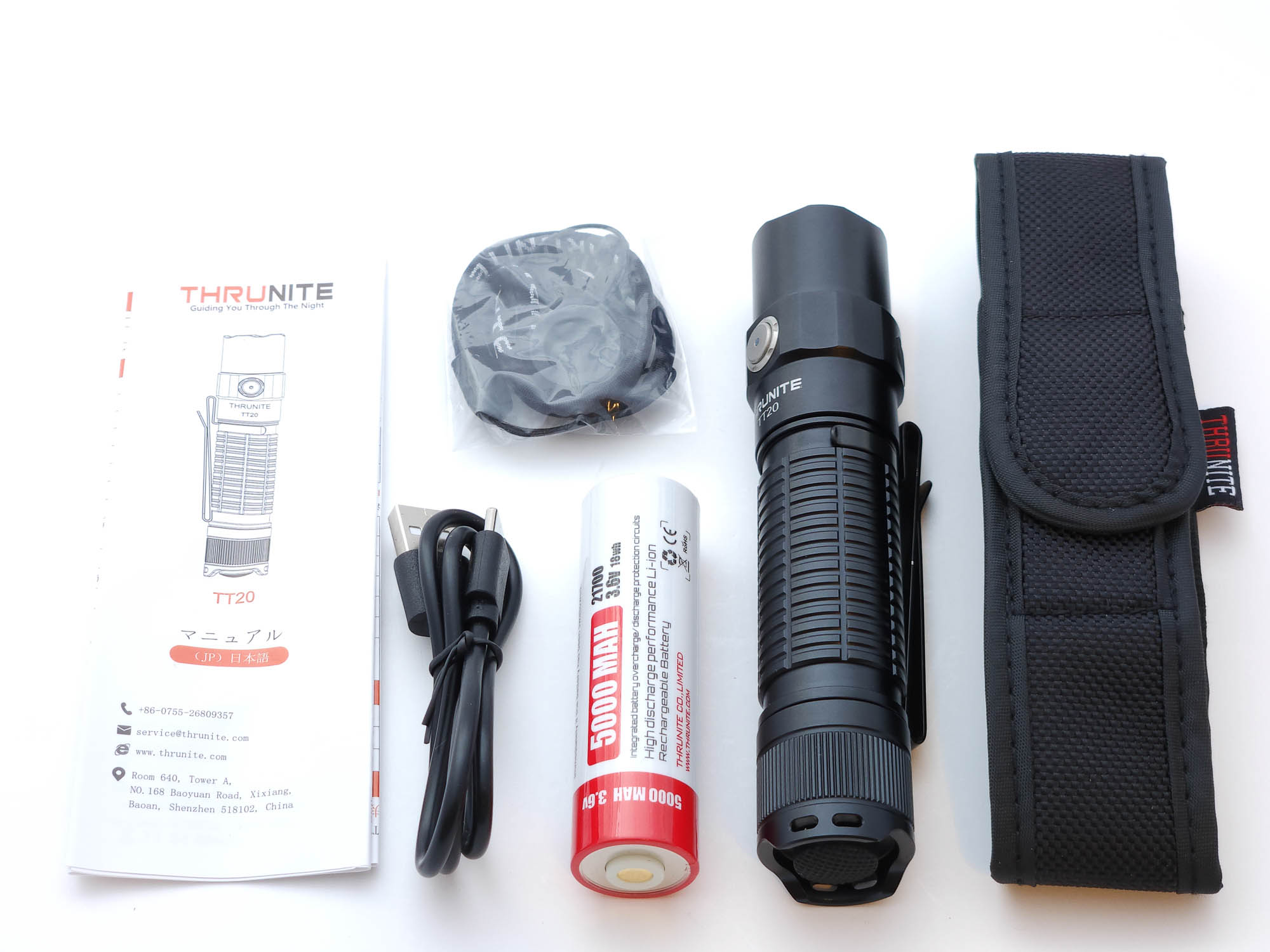
Flashlight in use
Being a 27100 light, the TT20 is a little too big to carry in a pants pocket comfortably, but there are plenty of other options, like a jacket pocket, clipped to a bag, or the included holster. It’s fairly hefty, so you’ll want to choose a carry method which will be comfortable for you.
When you take it out for use, you’ll find that it fits nicely in your hand. The electronic side switch is right where my thumb falls which makes for ease of use. That switch is very pronounced, so you’ll need to lock it out to prevent accidental activation, which you do by holding to go into firefly mode, then holding again. If you press the switch while it’s locked, the included indicator light will blink red. Hold again to unlock back to firefly mode.
The clip comes attached, though it’s on the head side of the light. Luckily, the clip can fit into the grooves at either end of the body, so you can take it off and clip it to the back for a deep carry. You still get about 1.5 cm of the tail sticking out, but that’s less than 10% of the total length. The clip is bi-directional and both sides have a large enough elbow to comfortably fit over thick items like jeans pockets or a baseball cap. The end of the clip falls right about where the head and body meet and because the head is wider than the body, that makes it a bit challenging to get it over the lip of a pocket without raising the clip up.
On the other side of the light, the forward-clicky tail switch is shrouded by the arms on the tail cap so that nothing sticks out. That’s good because it takes very little travel to activate it. There’s a good amount of space between the arms, though, and you can easily cover the switch with your thumb. The tail switch only controls instant turbo, regardless of if the light is on or not, so if you have a need to instantly hit turbo, this can help.
Both of the arms on the tail cap have two holes in them so you can attach the included lanyard to either without affecting its ability to tail stand.
Since the TT20 can sustain a good amount of light, it’s a good choice for use cases that require more light for extended periods of time. If you’re already carrying a bag, like when hiking, that would help with the size and weight, too.
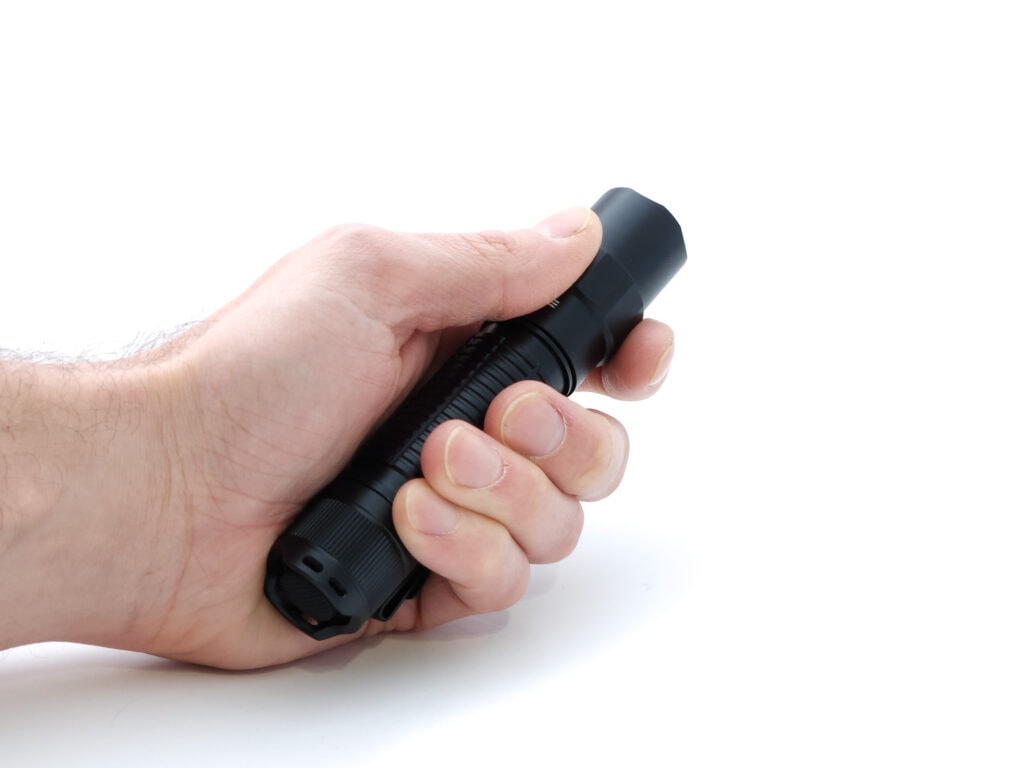
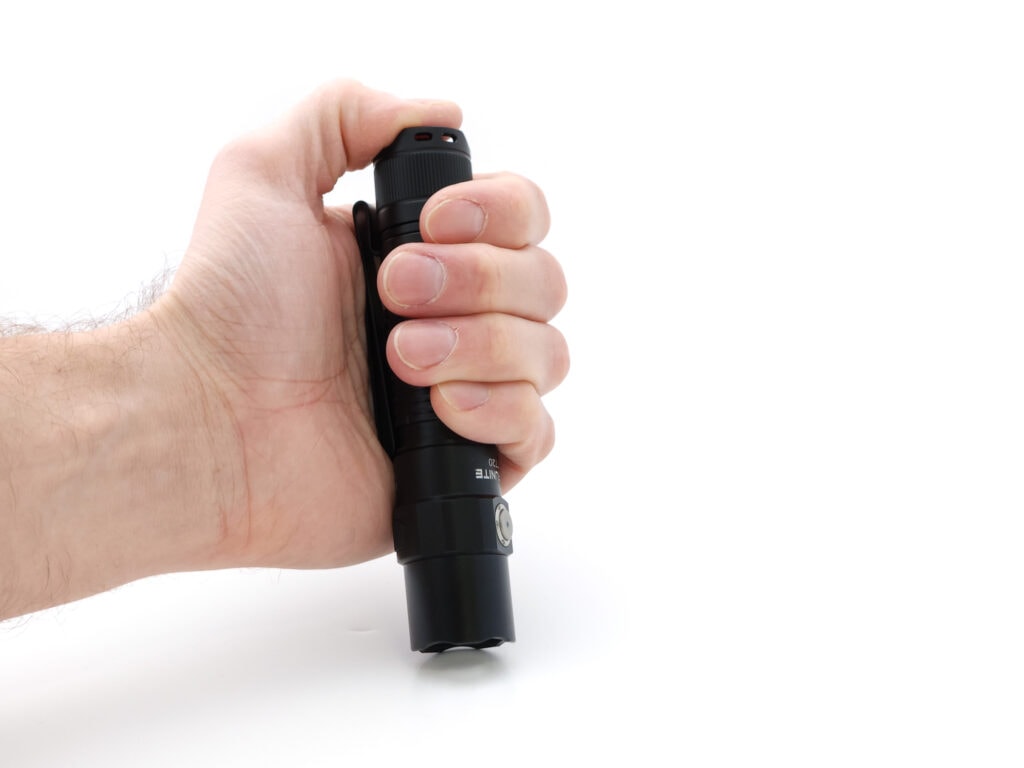
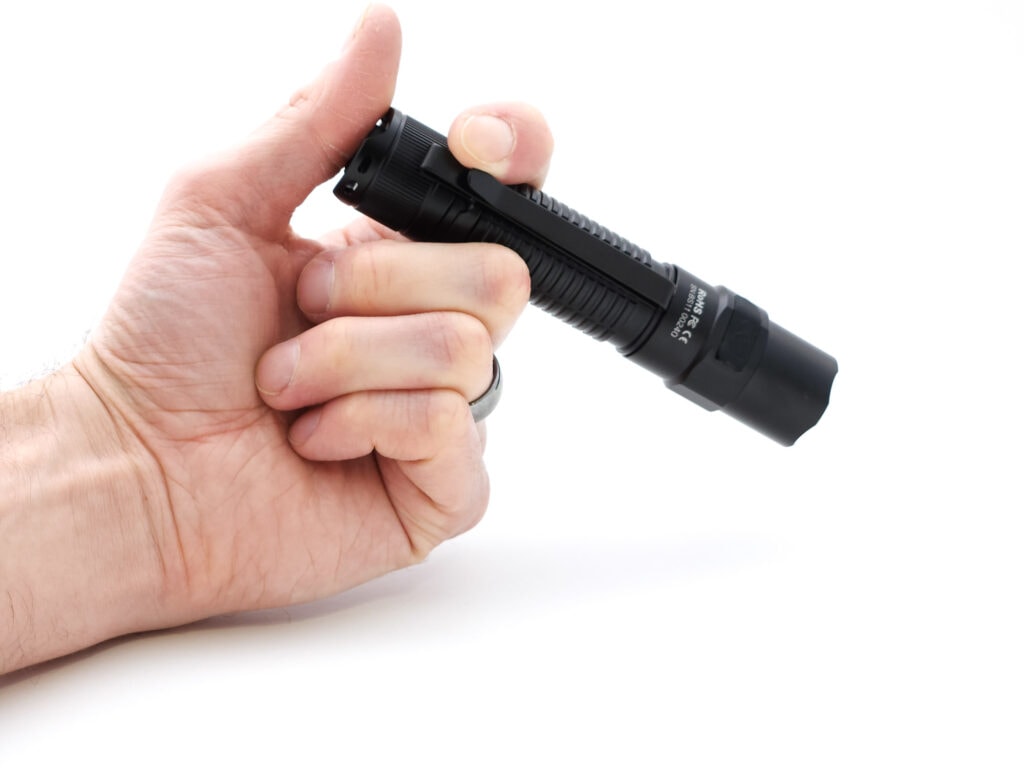
Build Quality and Warranty
The TT20 feels like it’s built like a tank, partially due to its weight. My sample model came in black anodized aluminum, but it’s also available in blue, gray, tan, and a red special edition dual-branded with The Outsider. They’re all functionally the same.
The body has thick, rectangular knurling consisting of rings and grooves parallel to the body. It makes me think of stacked bricks, for some reason. Anyway, it provides a good grip. The tailcap has thin herring-bone-like lines of knurling which are also pretty good.
The tail threads are the only ones accessible, as the head is glued on, and are also thick and rectangular, and well lubed. Unscrewing the tail cap is smooth. The threads are anodized, too, so mechanical lockout is also possible.
There is no knurling on the head, but there is an elevated ring with flat sections which will hold the light still on a flat surface. This is where the very pronounced switch is, as well as the USB-C charging port.
ThruNite’s standard warranty applies. Below is copied from the manual; see their Customer Service page for full details.
Warranty
1. 2-years free replacement: We will offer free replacement within 2 years of
purchase if problems develop with normal use.
2. 30-days refund by Amazon: You may return most new, unopened items sold
and fulfilled by Amazon within 30 days of delivery for a full refund.
3. Lifetime limited maintenance: As to those exceed 2 years of the purchase
date, we will still provide with maintenance service, but the cost of parts will be
charged and freight should be paid by customers.
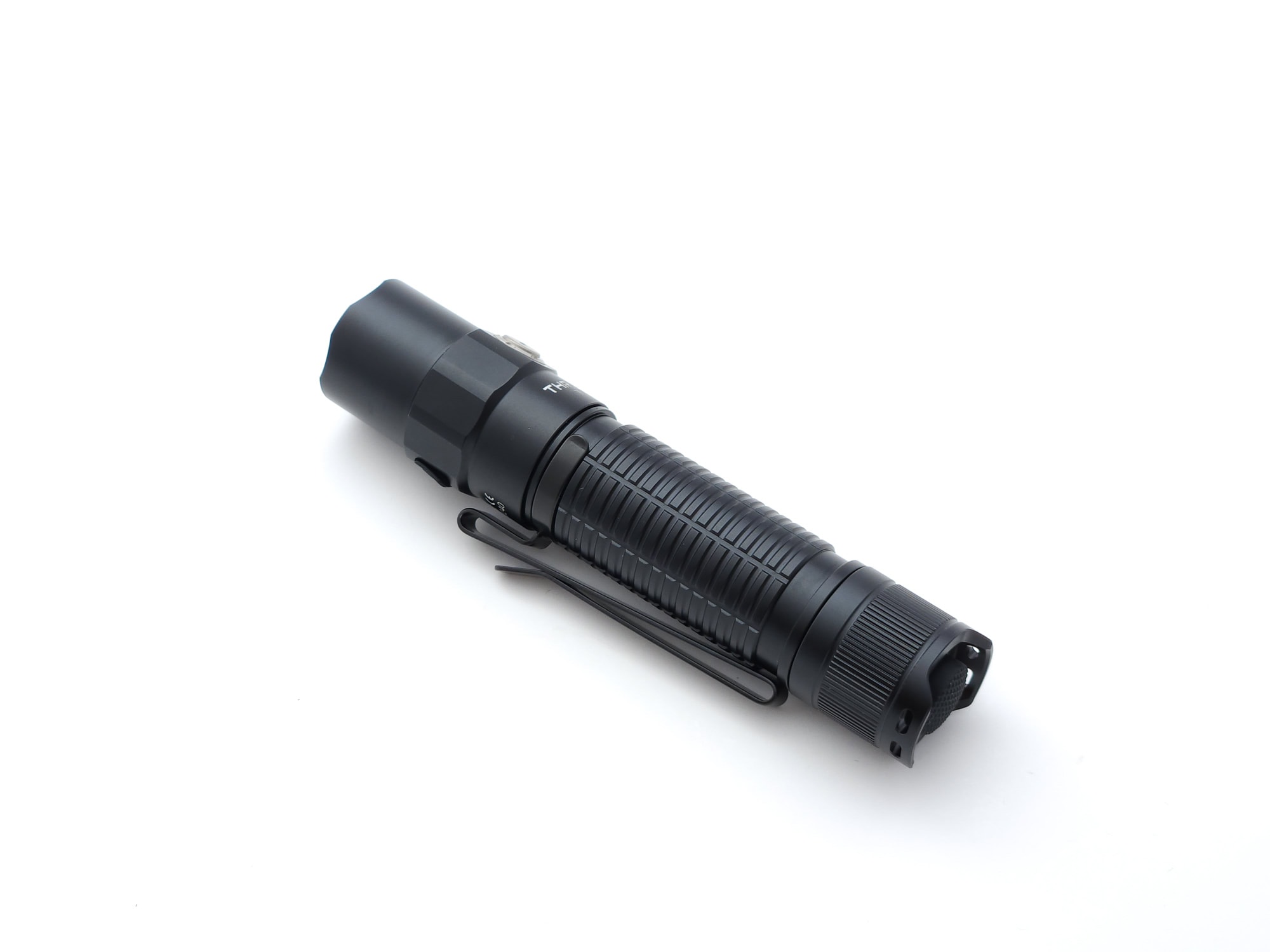
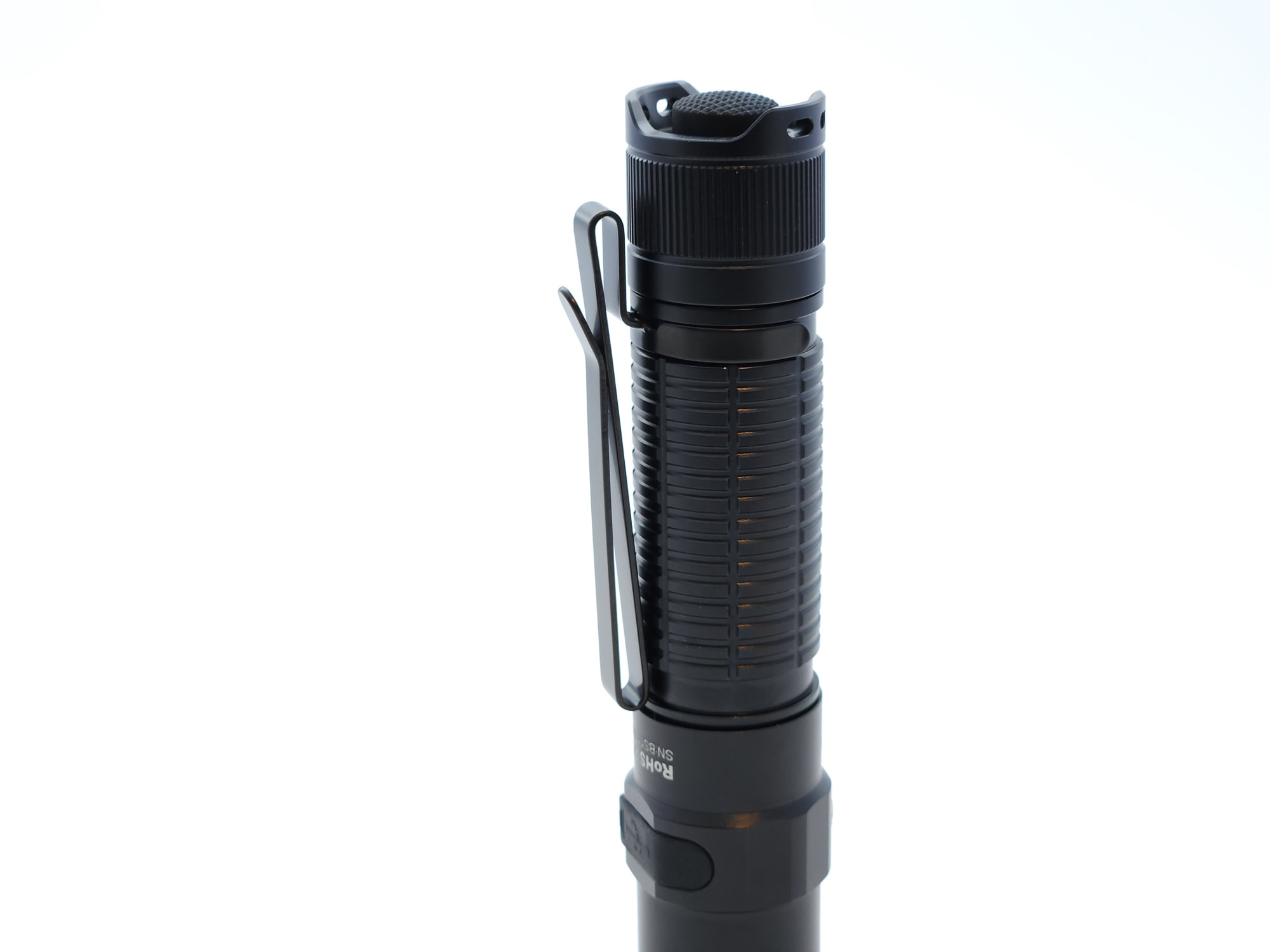
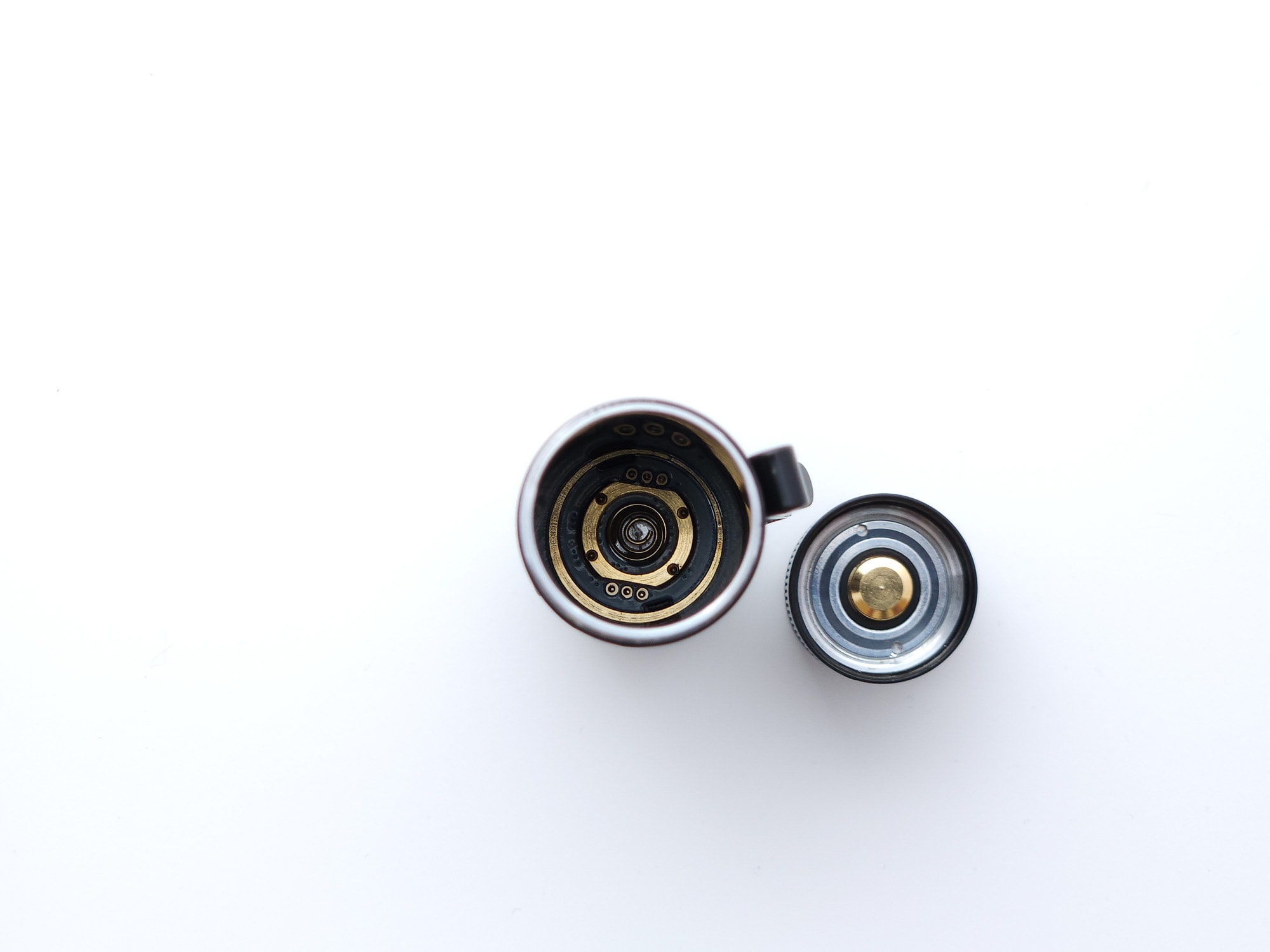
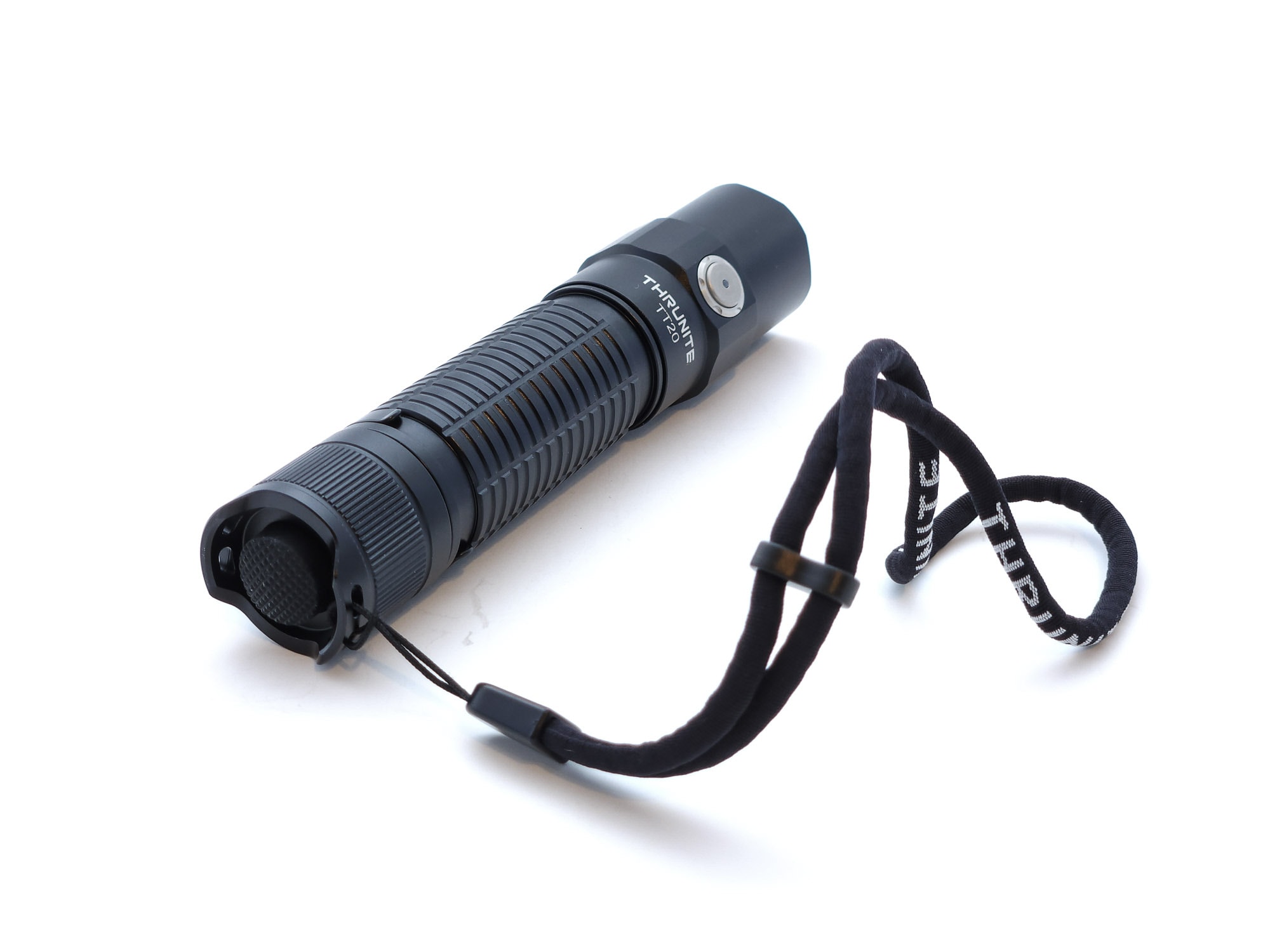
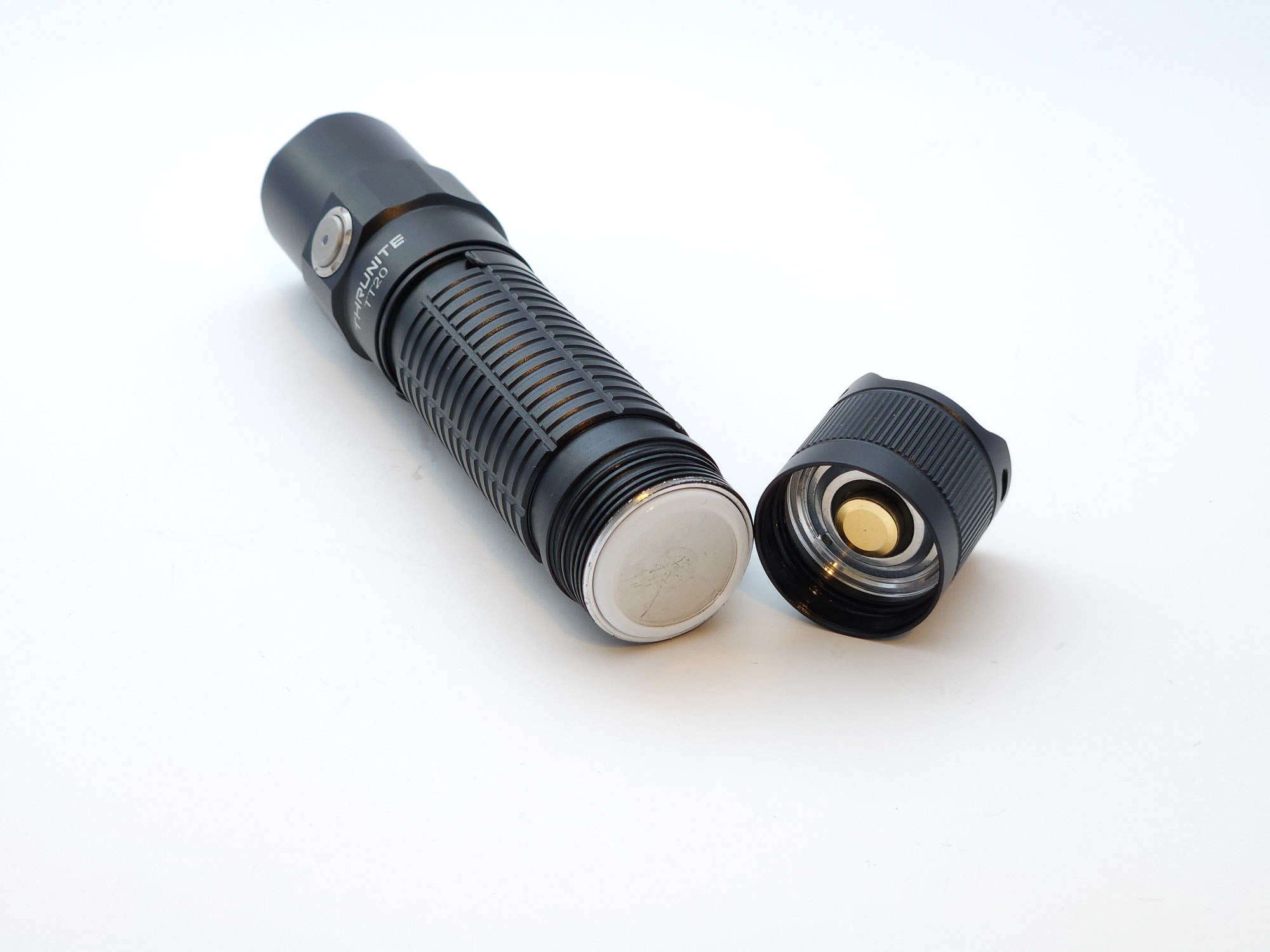
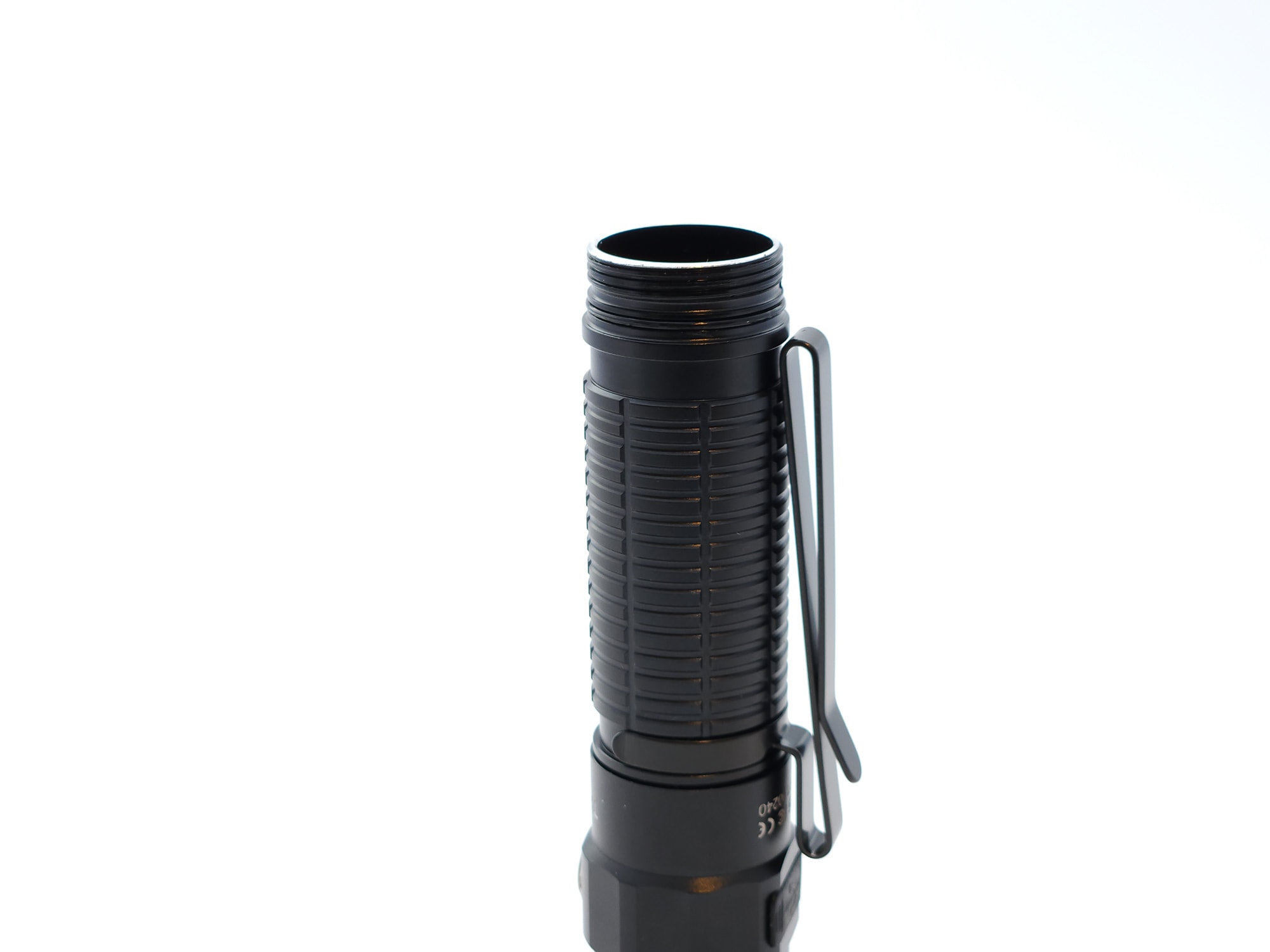
LED, Lens, Bezel, Beam, and Reflector
ThruNite armed the TT20 with a Luminus SST-70, which is a 6/12V, 50mm x 50mm quad die emitter. It’s basically four SST-20s under one dome on one chip. It only comes in 6500K, which has low CRI and a green tint; you can see how high DUV is in the chart below. But that’s not the point of this emitter; the SST-70 is a powerhouse, meant for high output rather than nice light.
The bezel of this light is lightly crenulated around the top, but completely smooth on the sides and keeps the anti-reflective coated glass lens in place atop the smooth reflector. The TT20’s beam has a bright hotspot and some usable spill without rings or artifacts. The hotspot is greenish, especially on lower modes, while the spill tends to be more on the blue side.
| Mode | CCT | CRI | DUV | Flicker |
| Firefly | 5288K | 62.3 | 0.0176 | 827 Hz |
| Ramp bottom | 5415K | 62.1 | 0.0174 | 1420 Hz |
| Ramp top | 5726K | 64.5 | 0.0118 | 30,525 Hz |
| Turbo | 5983K | 67.3 | 0.0095 | 27,350 Hz |
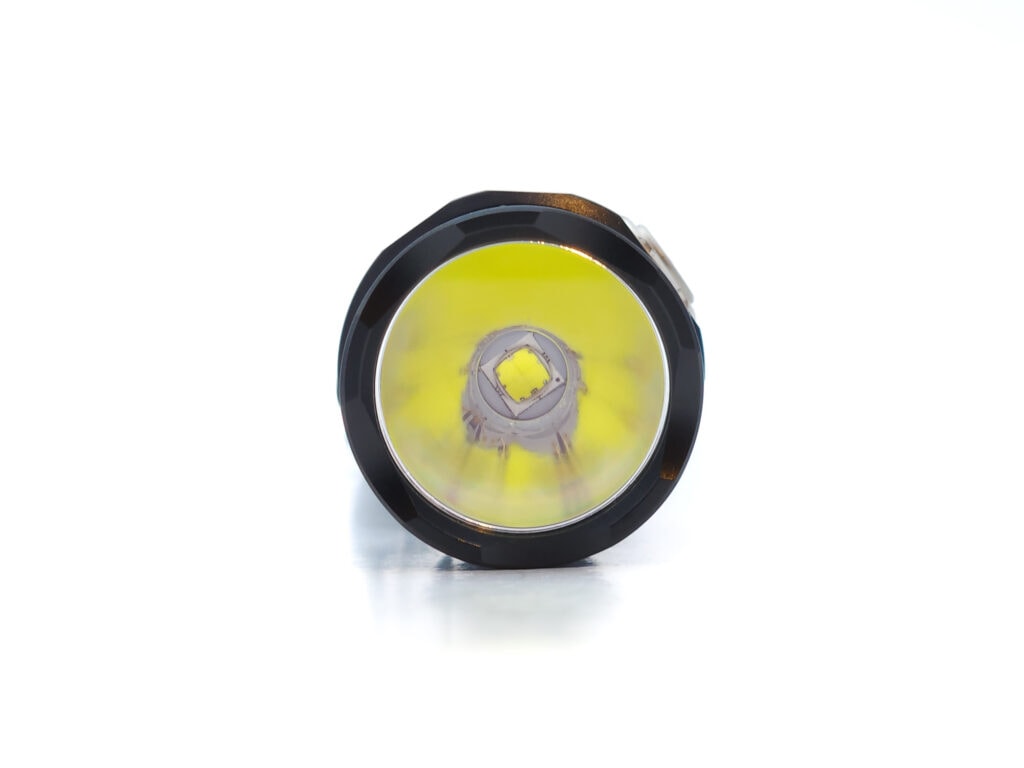
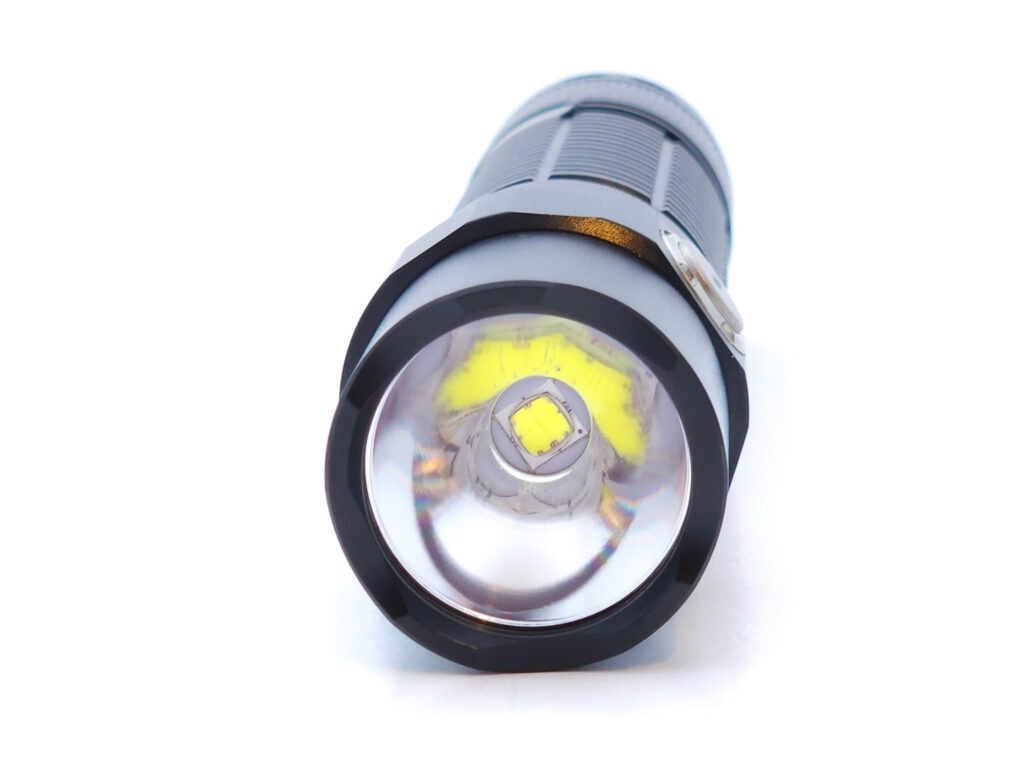
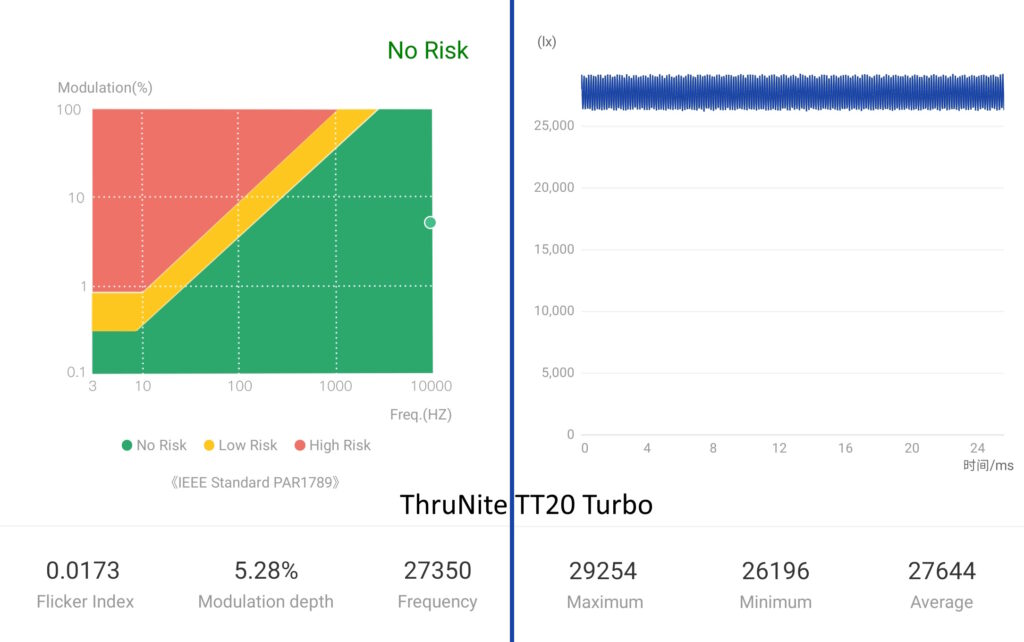
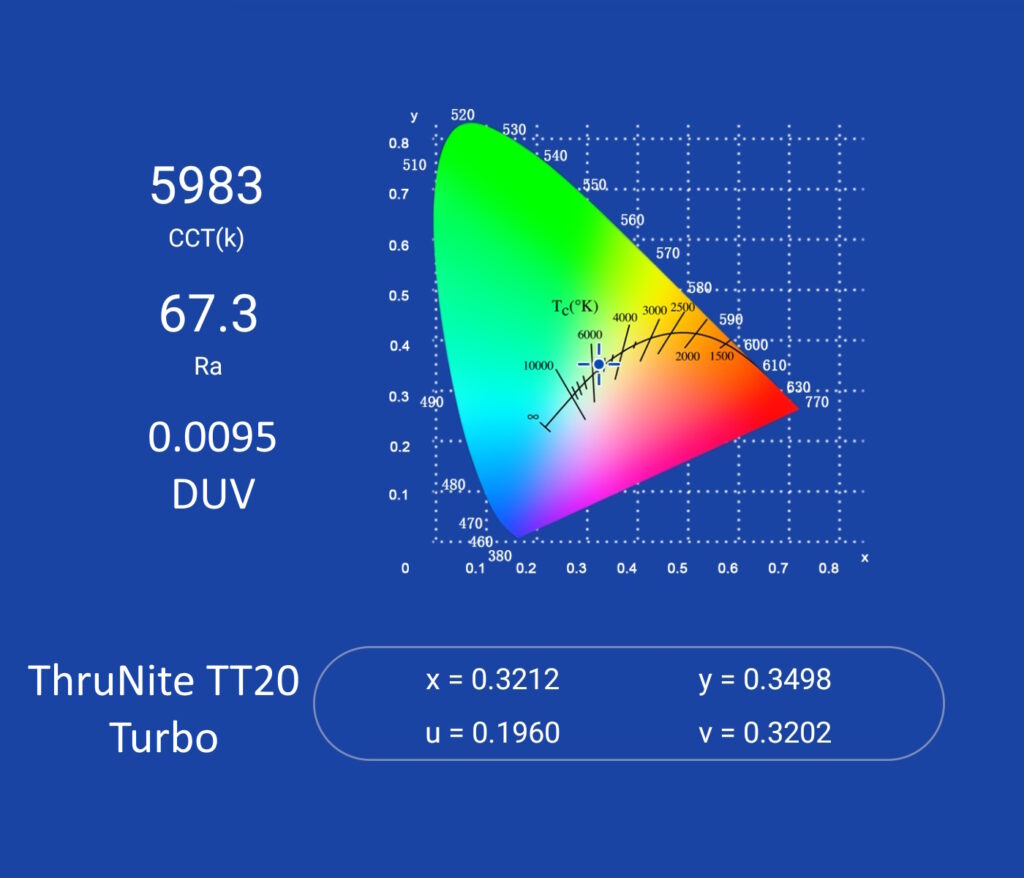
Dimensions and its competition
Dimensions:
| Millimeters | Inches | |
|---|---|---|
| Length | 136 mm | 5.3 in |
| Head diameter | 30 mm | 1.2 in |
| Body diameter | 26 mm | 1.0 in |
Dimensions are rounded to the nearest millimeter, and to the nearest tenth of an Inch.
Weight:
| Weight in grams | Weight in oz | |
|---|---|---|
| Without battery: | 98 g | 3.4 oz |
| With battery | 177 g | 6.2 oz |
Weight is rounded to the nearest gram, and to the nearest tenth of an Oz.
Flashlight size comparison with its competition:
Group 1: ThruNite Archer Mini, ThruNite Archer Pro, ThruNite Thrower, ThruNite TN12 Pro, ThruNite TT20
Group 2: Emisar D4V2, ThruNite TT20, Convoy S2+
Group 3: Nitecore P23i, Acebeam E70, ThruNite TT20, Convoy S21E
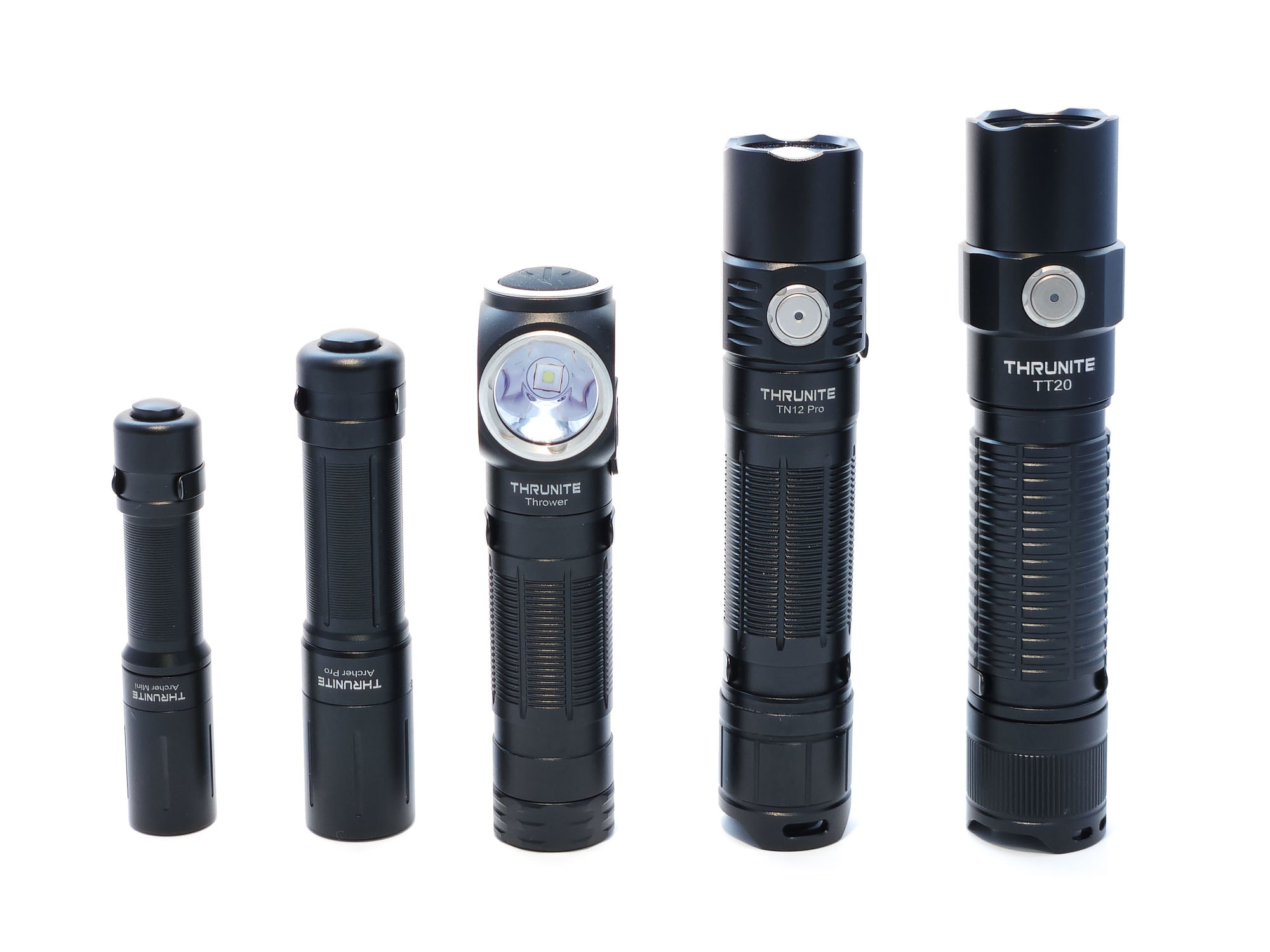
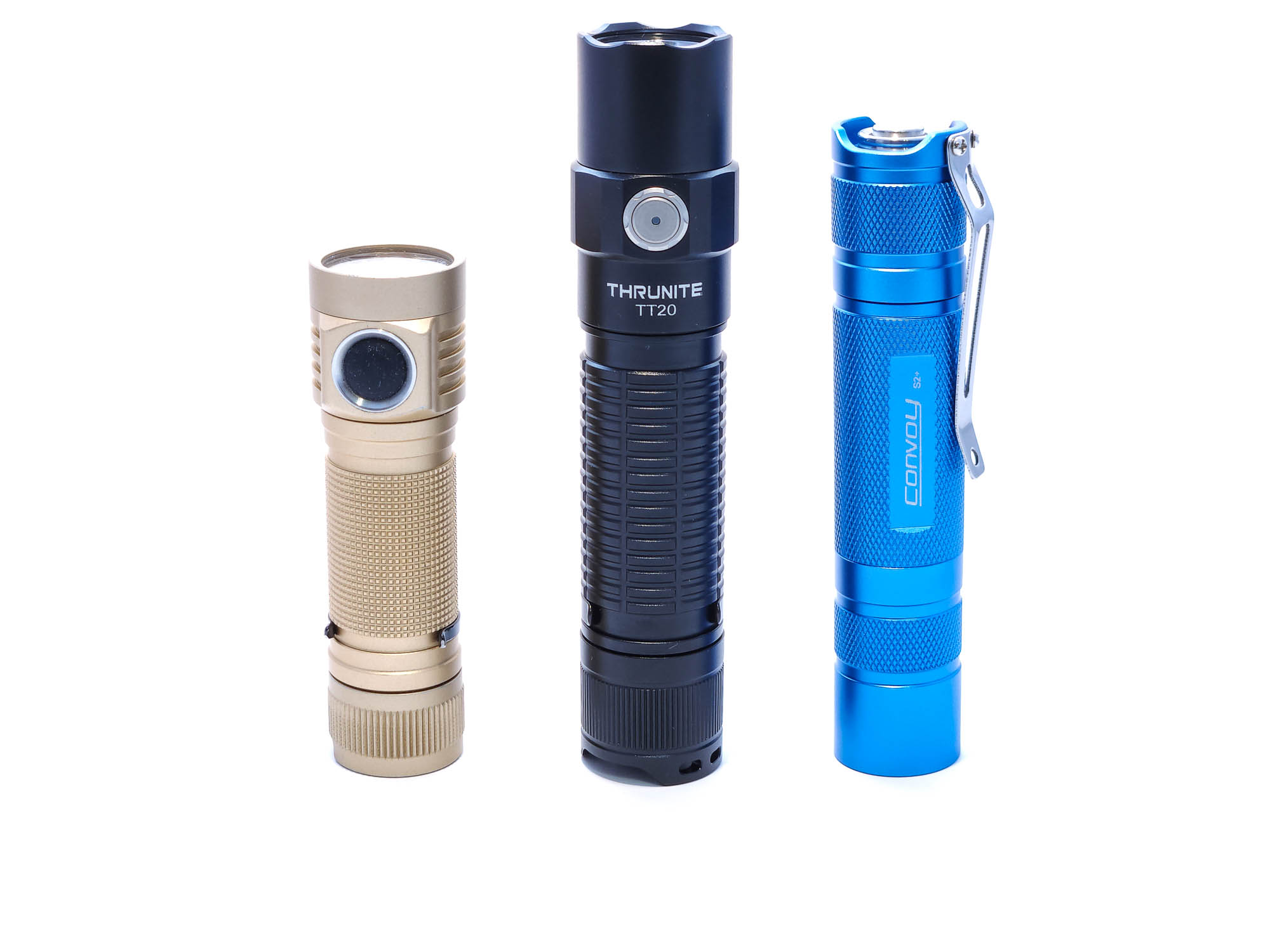
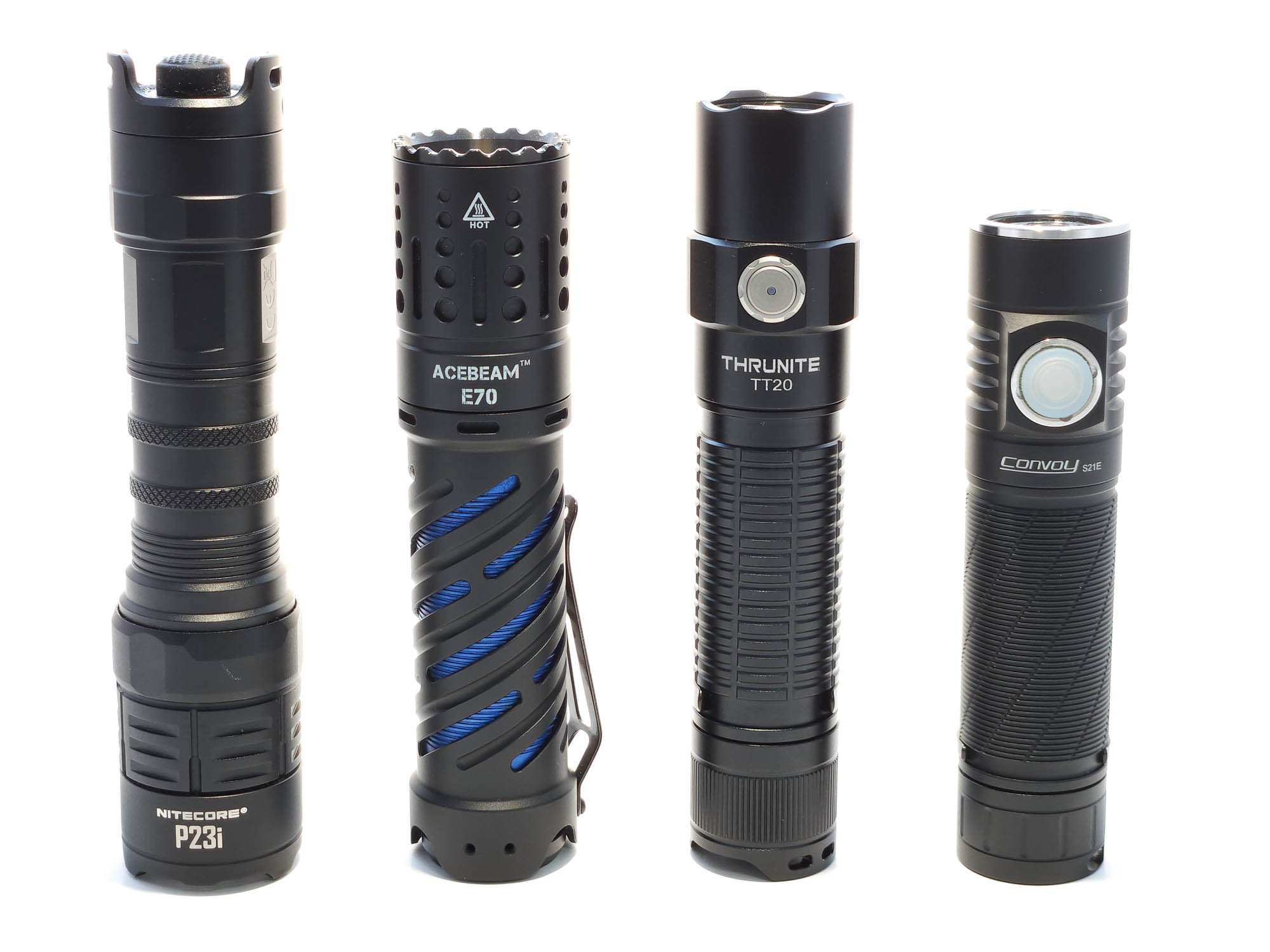
ThruNite TT20 UI: User Interface and Driver
The TT20 features smooth ramping instead of a traditional LMH UI.
Available modes:
- Firefly (moonlight), “infinity” smooth ramping, turbo
Available blinky modes:
- Strobe
From OFF:
- Side switch
- Press and hold: Firefly
- Single click: On to memorized ramp level
- Double click: Turbo
- 3 fast clicks: Strobe
- Tail switch
- Hold: Momentary turbo
- Click: Turbo
From ON:
- Side switch
- Press and hold: Ramp up/down (opposite direction from the last time you ramped)
- 1 click: Off
- Double click: Turbo
- 3 fast clicks: Strobe
- Tail switch
- Click: Off
Mode memory:
- The TT20 will remember the last used ramp level accessed through the side switch.
Shortcuts:
- To firefly: Hold side switch from off
- To Turbo: Double-click side switch or press the tail switch
- To Strobe: Triple-click the side switch
Low voltage warning:
- The indicator light in the side switch will turn red at 20% battery power and flash red at 10%
Strobe/blinkies
- Triple-click the side switch to get to strobe
Lock-out mode:
- From off, hold the side switch to get into firefly mode, then hold again to engage lockout.
- For extra security, while in lockout, you can click the tail switch to activate double lockout. In this mode, the indicator light in the button will stay red, so there will be a little bit of drain on the battery.
PWM
- Not visible
Additional/summary info on the UI:
- When you get to the top or bottom of the ramp, the light will blink, then begin ramping in the other direction.
ThruNite TT20 Charging and batteries
ThruNite includes a 21700 battery with the TT20 which is good, as this is the only battery it will take. Why? Because it’s proprietary, of course! The ThruNite 21700 has a button top which is the positive pole, but there is also an exposed ring around it which is a negative pole. If you look down the tube, you’ll see that there’s a spring in the middle for the positive button, but also a semi-ring around it for the negative terminal. The tail end of the battery is still a negative terminal, and that connects to the tail cap with a solid stud. Usually this kind of proprietary configuration is to run the side switch of dual switch lights without having to engage the tail switch or have a second tube in the body to carry the current..
Unfortunately that also means that this is the only battery that will work. I tried a regular button top 21700, but it would not turn on. The protection and customization circuitry add some length to the battery, making it come in at 76.5mm long; 6.5mm longer than a standard 21700. If that’s not enough, there’s a plastic shroud around the positive button to isolate it from the negative ring, but it’s slightly taller than the button which might make it difficult to make contact in an external charger depending on how the charger terminals are designed.
Thankfully there’s onboard USB-C charging, though it’s only USB-A to USB-C, as I was unable to get it to charge when using a C to C cable and my computer, or on a USB-C charger. In my testing, it took around 5 hours to charge the 5000 mAh battery from 2.95V when low voltage protection kicks in, to 4.12V when charging finishes. That’s a pretty long charge.
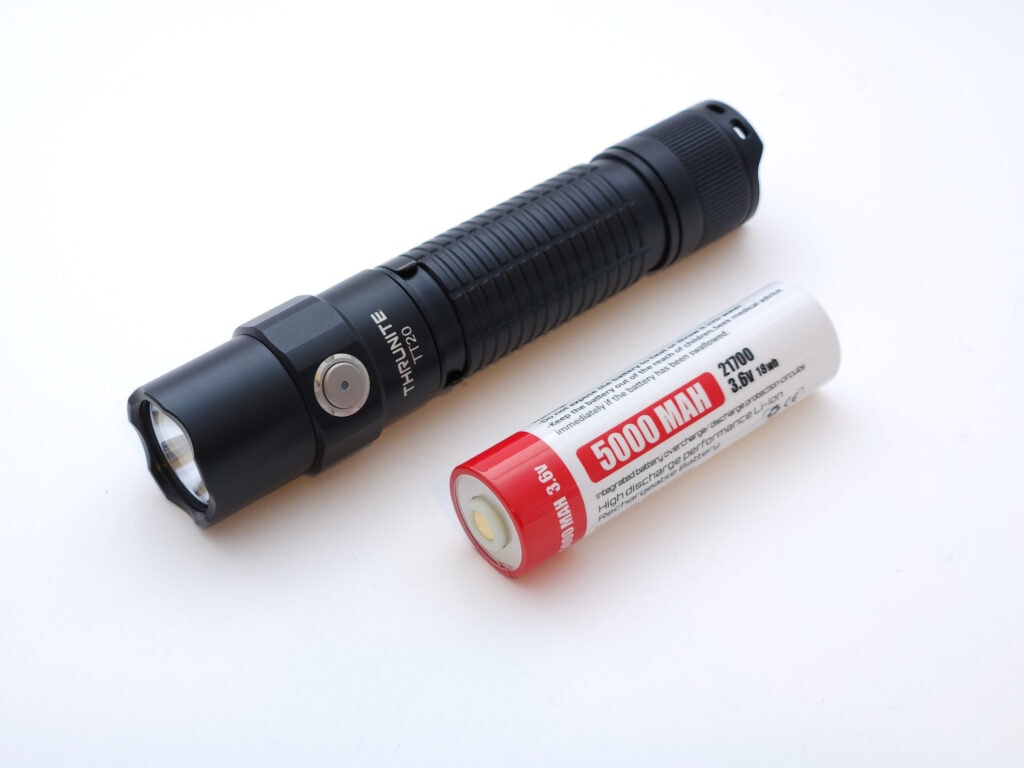

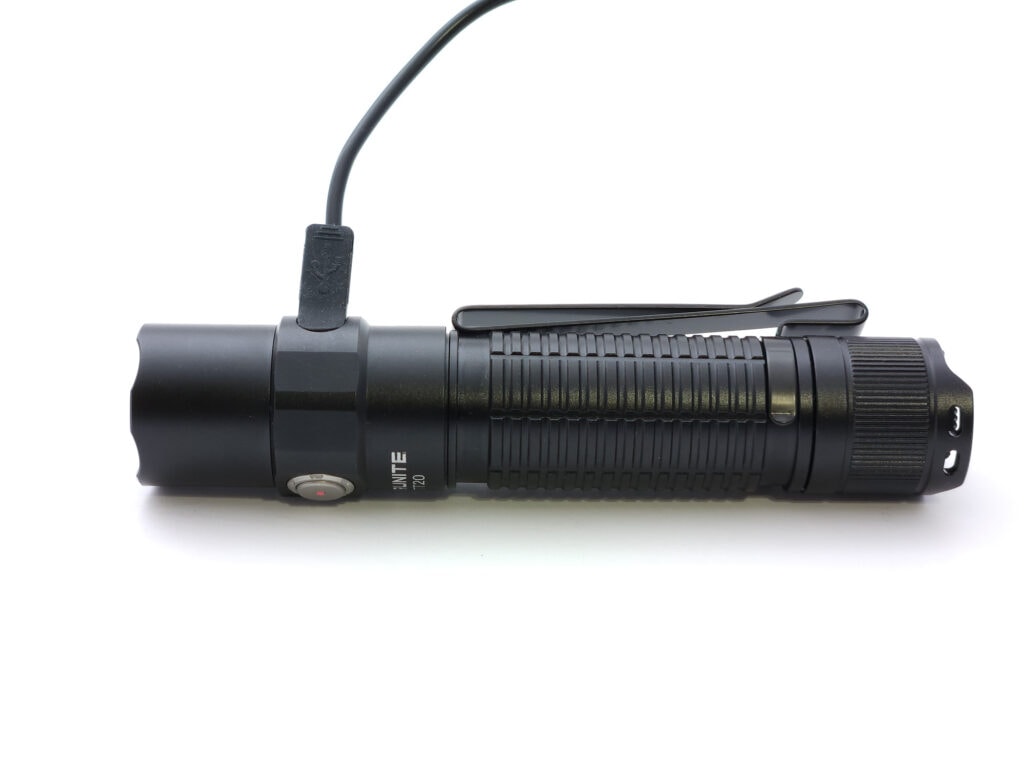
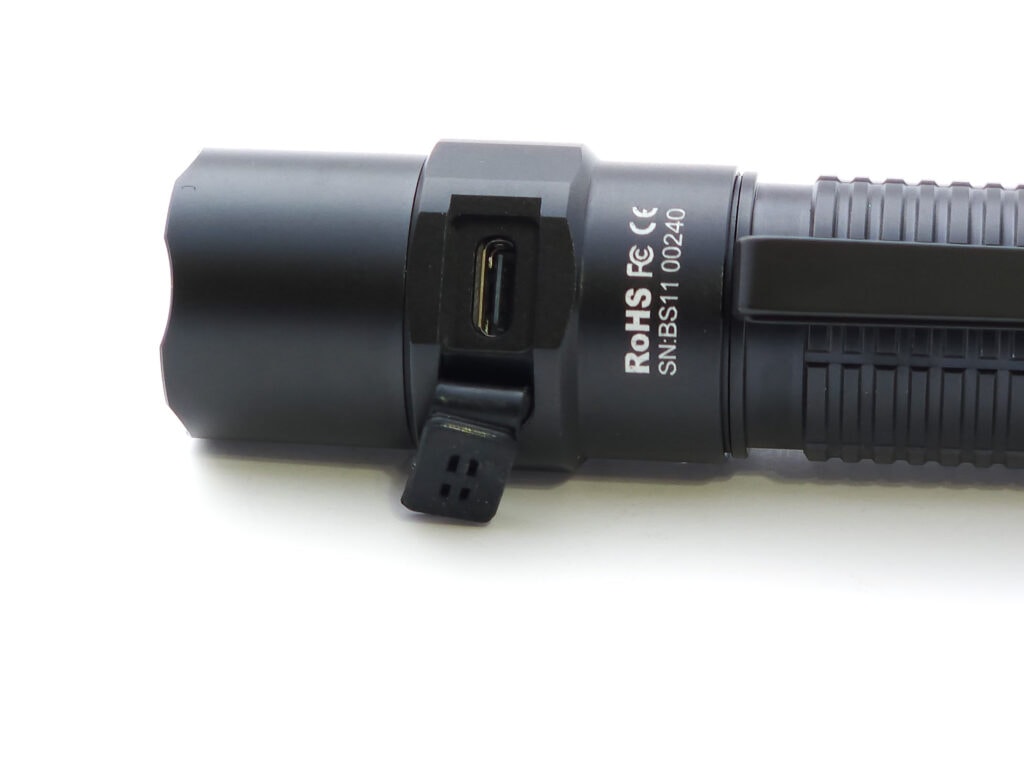
Performance test
To obtain these numbers, I used a very rudimentary integrated shoebox and ceilingbounce on my Samsung Galaxy S10. Measurements have been calibrated using a standardized calibration light provided by 1Lumen.
Lumen measurements (for each mode)
Turbo is the biggest miss here, being around 20% less than spec, though visually, the difference between 2000 and 2500 lumens is hard to discern. The top of the ramp measurement was pretty on target, and the step downs were also true to their numbers. Looks good to me.
| Mode | Specs | turn on | 30 sec | 10 minutes |
|---|---|---|---|---|
| Firefly | 0.54 | 0 | 0 | 0 |
| Ramp bottom | 31 | 23 | 23 | 23 |
| Ramp top | 1468/654 | 1451 | 1419 | 669 |
| Turbo | 2526/610 | 2186 | 2013 lm | 660 |
| Turbo at 3.6V | – | 1570 | 1208 lm | 773 |
Even though there is a negative pole on the battery, it only appears to be used for activating turbo with the tail switch, so I was unable to measure current.
Battery Life: Runtime graphs
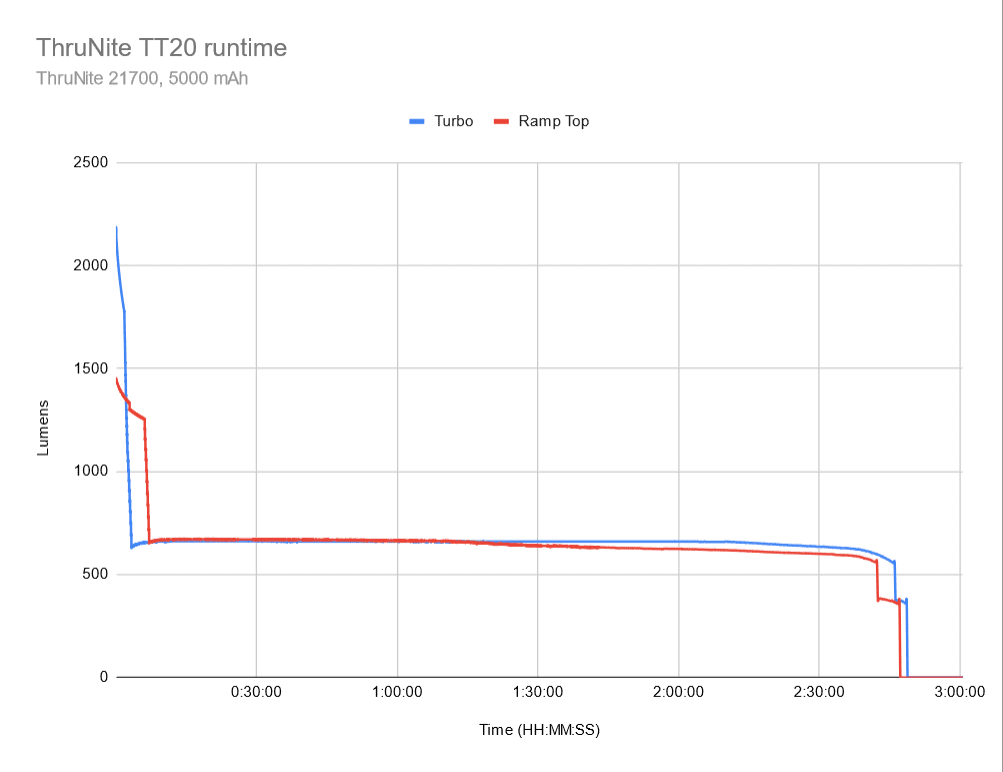
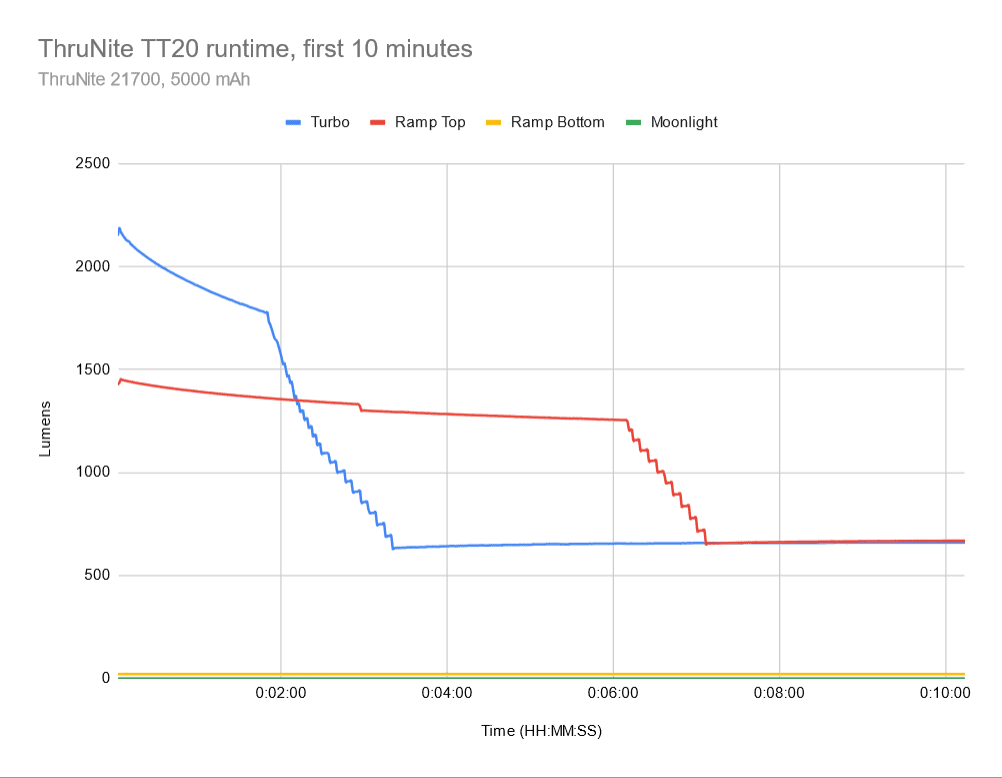
Runtimes for turbo and the top of the ramp missed by over an hour, or 25%, each, which is pretty significant. However, getting close to 3 hours’ worth of light isn’t bad, especially when it’s a solid 650 lumens or so. I didn’t test the bottom of the ramp or firefly mode, or else we’d never get this published!
| Mode | Specified runtime | Measured runtime ANSI | Time till shut off |
|---|---|---|---|
| Firefly | 64 days | – | – |
| Ramp bottom | 90h | – | – |
| Ramp top | 3h 58min | 2h 47min | 2h 47min |
| Turbo | 3h 59min | 2h 49min | 2h 49min |
About ANSI FL1 standards: The runtime is measured until the light drops to 10% of its initial output (30 seconds after turning on). This does not mean that the flashlight is not usable anymore. The last column shows how long the light actually works till it shuts off. If there is a + symbol, it means that the test was stopped at that particular point, but the light was actually still running. This happens on certain occasions, with certain drivers, firmware, or batteries.
Peak beam intensity and beam distance measurements
The numbers for candela were obtained with a UNI-T UT383S luxmeter at 5 and 15 meters, then averaged.
I was actually surprised here to find that the candela reading at 30 seconds of turbo actually exceeded specs. The SST-20 is known to be a throwy emitter, so I would assume that would be the case for the SST-70 as well, since it’s basically 4 SST-20s.
| Mode | Specs | Candela measured | Meters | Yards |
|---|---|---|---|---|
| Ramp bottom | – | 165 cd | 26 m | 28 yd |
| Ramp top | – | 12,755 cd | 226 m | 247 yd |
| Turbo | 16,650 cd | 20,163 cd | 284 m | 311 yd |
About peak beam intensity: Peak beam distance according to ANSI FL1 standards: The calculated value of distance in meters at which the flashlight produces a light intensity of 0.25 lux. (0.25 lux is about the brightness of a full moon shining on an object). The columns ‘Meters’ and ‘Yards’ use rounded numbers.
Beamshots
These were taken with a Samsung Galaxy S22+ using pro mode and the following settings:
- WB 5000K
- ISO 200
- Speed 0.5
Distance to the other end of the playing field is 100 meters.
The TT20 gives you a big swath of light to work with.
Beamshots of the following flashlights compared:


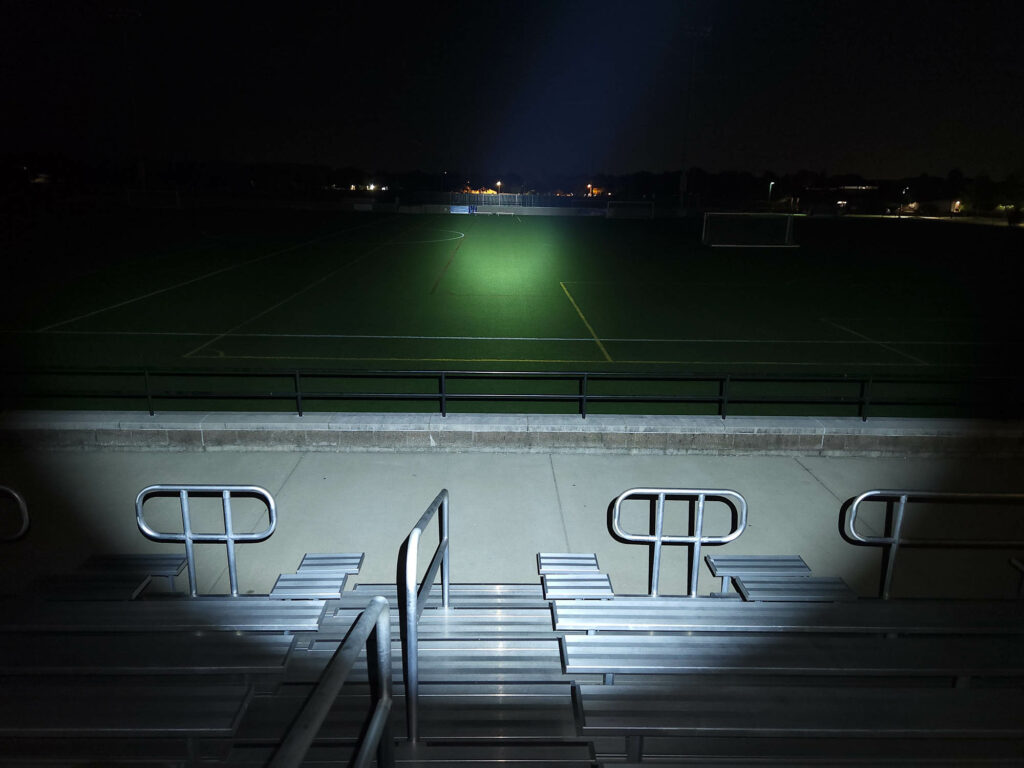
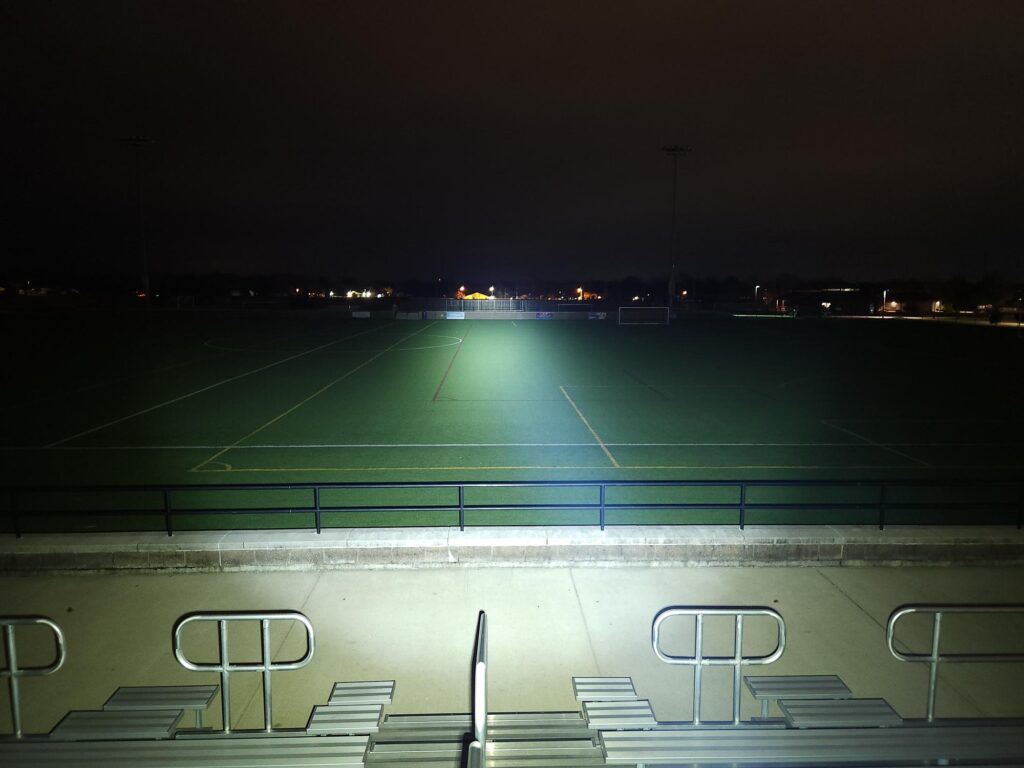
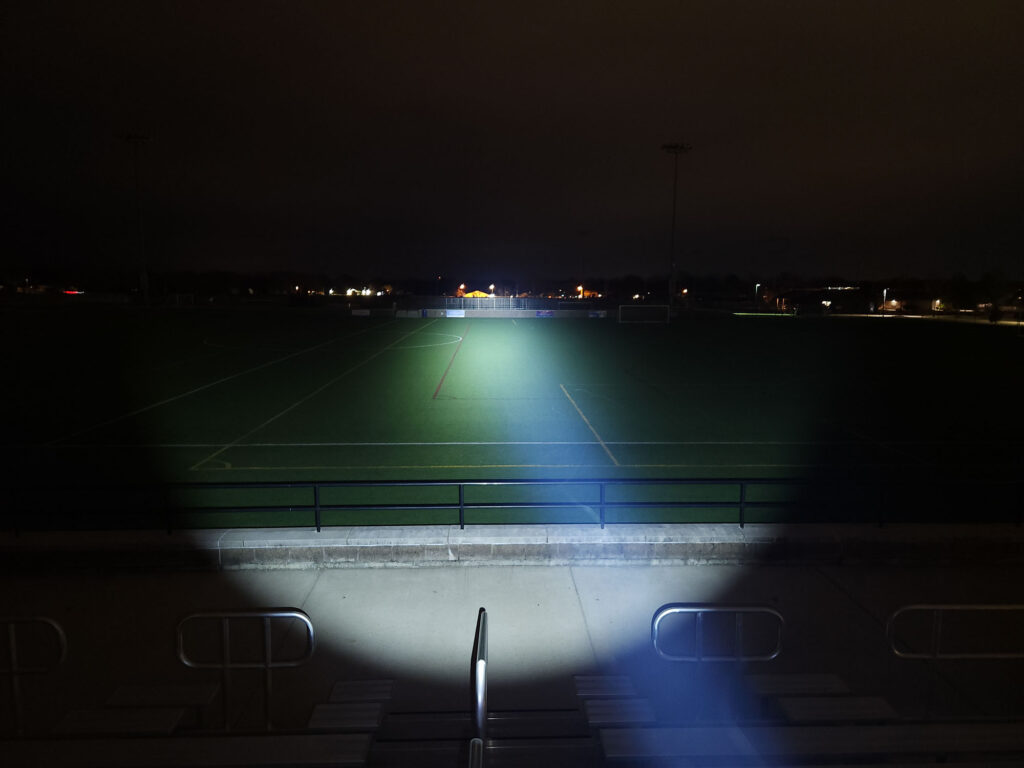

Disclaimer: This flashlight was sent to me for review at no cost by ThruNite. I have not been paid to review, nor have I been holding back on problems or defects.
Final Verdict
Pros
- Complete package with battery and onboard USB-C charging
- Instant access to turbo
- High power and throw
Cons
- Proprietary battery
- Long charge time
- Green tint in the beam
Explanation on star ratings:
1: Avoid: a match would be a better choice – 2: Poor: significant defect or issues; almost unusable – 3: Average: some defects or issues; but still usable 4: Good: recommended (minor issues) – 5: Great: highly recommended

4 stars: ★★★★
While our star rating provides a reliable indicator, we encourage you to read the full review to make an informed decision based on your own needs and preferences.
ThruNite comes through with another high powered light. The TT20 isn’t going to give you the prettiest light, but that’s not the point; it will, however, give you plenty of light and throw it pretty far, especially with instant access to turbo via the tail switch.
That is, if you don’t mind the proprietary battery. I understand the design need, but that also means that if you want to use it on turbo/high for more than 3 hours at a time, with a 5 hour charge in between uses, you have to buy more of ThruNite’s 21700s.
Overall, I give the ThruNite TT20 4 stars.
Buy your ThruNite TT20
1lumen selects and reviews products personally. We may earn affiliate commissions through our links, which help support our testing.